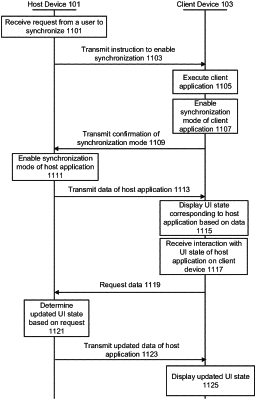| CPC H04L 65/612 (2022.05) [G06F 16/27 (2019.01); H04L 67/04 (2013.01); H04L 67/10 (2013.01); H04L 67/1095 (2013.01); H04L 67/131 (2022.05); H04L 67/51 (2022.05); H04L 67/55 (2022.05); H04L 67/01 (2022.05)] | 16 Claims |

|
1. A computer-implemented method for synchronizing a user interface (UI) state of content of a host application on a host device with a client application on a paired client device that is paired to the host device, the method comprising:
receiving an event at the host application;
synchronizing the UI state of the content of the host application by:
determining content data that is related to at least a portion of the UI state of content displayed by the host application,
identifying the client application, which corresponds to the host application, by communicating a request to the paired client device from the host device and receiving a response to the request that identifies the client application; and
communicating, to the client device, the content data that is related to the at least the portion of UI state of the content of the host application, where the host application is configured to show a distinct but synchronized UI to support continuing operation of the host application at the client device;
wherein the client application is configured to display a UI state of content of the client application, based on the related content data of the at least the portion of the UI state of the content of the host application,
wherein the client application, in a first state that is independent of a UI update to the host application, processes a first client user input and updates the client UI, while the related content data of the at least a portion of the UI state of the content communicated from the host application is stored in the client application without changing the first state to maintain the synchronization, and
wherein the client application, in a second state, resumes executing UI synchronization with the host application responding to a second client user input of the second state that causes one or more client UI updates and a change of the related content data of the at least a portion of the UI state of content from the host application, and
wherein the host device is connected with the paired client device via a wireless link.
|